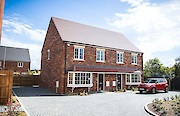


Mortgage Advisor & Director

Mortgage Advisor & Director

A prefabricated (or ‘prefab’) house is a unique type of property usually constructed somewhere off-site (like a factory) and then assembled on location. Prefab homes come in various formats, and although they can be cheap and efficient to build, getting a mortgage on a prefab house can be challenging.
Can you get a mortgage on a prefab house?
Yes, it’s possible to get a mortgage. However, it will depend on the exact type of prefab construction, your financial circumstances, and the lender you approach. Because prefab houses are deemed ‘non-standard construction’ by lenders, there are often stricter eligibility criteria and limits around how much you can borrow.
Mainstream lenders are cautious with prefab houses and may have additional requests to offset the added risk. This could mean larger deposits, higher interest rates, or specifying you take out an expensive insurance policy. The good news is that some specialist lenders in the UK don’t share the same views of prefab homes.
Types of prefab houses in the UK
Here are some examples of common types of prefab styles and constructions:
- Airey
- AIROH
- Arcon
- BISF houses (with steel frames)
- Cornish Unit
- Huf Haus
- Phoenix
- Reema
- Uni-Seco
- Unity Structures
- Wates
- Woolaway
- Wimpey No-Fines
Most post-WWII prefab homes used PRC (Pre-cast Reinforced Concrete), which only had a limited lifespan. However, most modern prefab houses are built with longer-lasting materials.
Mortgage challenges with prefab houses
The key reasons it can be challenging to get a mortgage for a prefab house come down to:
Construction quality
The quality across prefab houses isn’t standardised and there can be huge differences in the build quality and materials used (some older homes even used asbestos). Even though some modern prefab homes are built to a high standard, some lenders don’t have the time or resources to verify this.
Resale value
Due to the type of construction, there’s less demand for prefab houses, which means it might be difficult to sell the property in future. This can be a concern for some lenders, who may also be worried about the house maintaining value in the case of repossession.
Insurance
Getting insurance for a prefab home can be difficult or costly to arrange. Most lenders insist you have buildings insurance to get a mortgage, and unfortunately, these added insurance costs can even impact your mortgage affordability. If insurance is hard to secure for the prefab house, it might put the lender off.
Lending criteria for this type of property

Here are some of the key factors that will be looked at when it comes to eligibility criteria for mortgages on prefab houses in the UK:
- Construction condition: To minimise risk, some lenders will only accept prefab houses built after a particular year, or homes created using specific construction methods. Older prefab houses had an intentionally short lifespan, whereas modern prefab homes can be extremely sound structurally.
- Property age: Some older prefab houses were built with an expected use of around 60 years, but certain homes only had a planned life of 10 years. Some lenders will immediately decline a mortgage for prefab homes built during specific periods because materials like asbestos were used. The age of a prefab house can often tell a lender quite a lot.
- Deposit: Due to the perceived added risk with some prefab houses, most lenders will have higher deposit requirements, meaning a lower loan-to-value (LTV) ratio. However, the range of deposits can be quite wide, often falling between 15% and 50%, so it’s crucial to speak to the right lender.
- Certificates, guarantees, and surveys: Lenders will require a specialist survey to get the full picture to highlight any structural deficiencies. Also, if it’s an older property that’s been improved, you’ll need certificate proof of any PRC repairs that comply with standards like PRC Homes Ltd. or British Board of Agrément (BBA). Sometimes minimum warranty periods are also needed.
- Credit history: Because prefab homes can involve more risk for lenders, they’ll want to carry out a thorough check of your credit history. If you happen to have bad credit, don’t fret, it can still be possible to get a mortgage if you deal with the right lenders.
Tips for making a property mortgageable
Here are some tips to help increase your chances of making sure a prefab house is mortgageable:
- Work with a specialist surveyor: It’s a good idea to get a RICS (Royal Institute of Chartered Surveyors) home buyers survey and a building survey from a RICS-qualified surveyor specialising in non-standard constructions or prefab houses. Ideally, get this before approaching a lender, your adviser can help you arrange this.
- Check the foundations: If possible, ensure the prefab house meets UK building regulations and has a solid, permanent foundation - a structural survey can confirm this if you request. Lack of a secure or permanent foundation is a common reason lenders decline mortgage applications.
- Upgrade materials: If you can, upgrade or replace any outdated materials with more modern alternatives. Just double-check before you do any of this that the improvements would qualify for specific certifications, such as a PRC, CML (Council of Mortgage Lenders), or BBA certificate - whichever is most relevant.
- Get insurance: If you can get ahead of the curve by securing the necessary buildings insurance policy to cover your prefab house, this removes one worry for lenders and can increase their confidence in providing you with a mortgage.
How to get a prefab house mortgage
Here are some straightforward steps to follow if you want to get the best mortgage deal for a prefab house:
1. Gather your details: Along with your personal documents (proof of address, identification, and 3 months of payslips and bank statements), you should get as much information as you can relating to the prefab house you want. Ideally including a specialist survey with the prefab construction specifics and age.
2. Get expert advice: It’s hard to get a mortgage for a prefab home without advice from an expert adviser. Specialist advice is extremely worthwhile because it prevents unnecessary rejections or unwanted marks on your credit file. It also ensures you get the best terms and rates.
3. Apply for a mortgage: Once your broker has checked over your details (including a review of your credit reports), and assessed the prefab home, they’ll introduce you to the right lender for your specific type of prefab house. Your broker will also help walk you through the mortgage application process.
If you want to speak to one of our experienced brokers who specialises in mortgages for prefab houses, you can get started here with a free, no obligation chat:

Get tailored mortgage advice for prefab homes
Available prefab mortgage lenders
If you’re wondering who’ll even give you a mortgage on a prefab house, you’ll likely struggle to find many willing mainstream UK lenders. Here are some examples of the minority of high street lenders who are open to prefab house mortgages:
- Halifax: Although Halifax will consider certain types of PRC homes, Halifax declines mortgages if the type of construction has been designated defective (unless they’ve since been suitably repaired with corresponding certificates).
- HSBC: May consider Wimpey No-Fines and Laing Easiform houses built after 1945, subject to valuer’s comments and a lower maximum LTV ratio of 80%. HSBC will also consider certain kit-built constructions like Huf Haus, Potton, and Skandia-Hus, with an 80% LTV and a warranty if less than 10 years old.
- Virgin Money: Only considers PRC homes repaired under an approved scheme and less than 2 storeys with no adjacent unrepaired property. However, Virgin won’t accept some properties that use Modern Methods of Construction (MMC) like Large Panel Systems (LPS) or high alumina cement.
If you want to see the full range of lenders who can provide the most flexibility for your prefab house mortgage, while still offering the best rates, it’s well worth getting one of our advisers to introduce you to a suitable specialist lender.
How much can you borrow?
The typical amount you can borrow is 4.5 times your salary. Sometimes this can be stretched, but it’s unlikely with a prefab home, and some lenders may even use a lower salary multiple.
Use our calculator below to get an idea of how much you could borrow:
Why choose Teito for a prefab house mortgage
Our brokers specialise in securing mortgages for challenging properties, including prefab houses. To get a mortgage for a prefab home, you’ll often need to approach niche lenders who can be more flexible.
Because our brokers have plenty of experience with non-standard constructions, they can help you arrange necessary surveys, evaluate your finances, and introduce you to the best lender for your circumstances.
Here are some more of the reasons people choose us when getting a mortgage for a prefab house:
- Our brokers specialise in all types of prefab homes - modern and old
- We can introduce you to specialist lenders with great rates
- Your first chat is free with no obligation to proceed
- We are 5-star rated on leading review sites
Ready to take advantage of a free, no-obligation chat with a broker who specialises in prefab house mortgages? Get started here.
FAQs
Yes, but it’s difficult. Most lenders will only consider concrete prefab homes built in a certain way or repaired to meet specific PRC certifications. Typically, the older the home, the harder it will be, with preference often given to more modern builds (but not always).
Choosing an Adviser
Selecting a qualified and experienced mortgage adviser is of great importance. To choose a suitable adviser, evaluate their qualifications, experience, and reputation, and ensure they are regulated by the Financial Conduct Authority (FCA).
Read reviews from previous clients and make sure they provide a clear explanation of the products and services they offer, as well as the fees and charges associated with them.





















































































































































